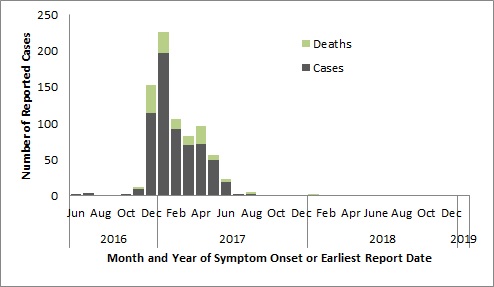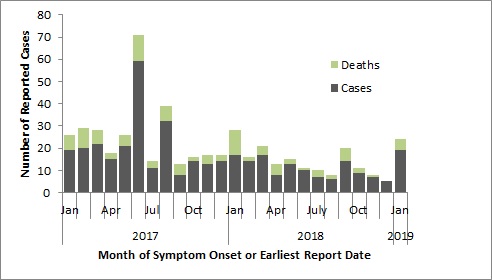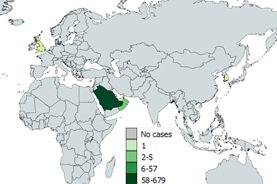Human Emerging Respiratory Pathogens Bulletin - Issue 25 January 2019
Download the alternative format
(PDF format, 645 KB)
Organization: Public Health Agency of Canada
Published: 2019-02-14
Monthly situational analysis of emerging respiratory diseases affecting humans
| Novel influenza1 | Cumulative Case Count2 | Deaths | Case Fatality Rate %3 |
|---|---|---|---|
| A(H7N9) | 1,567 | 613 | 39% |
| A(H5N1) | 860 | 454 | 53% |
| A(H9N2) | 48 | 1 | 2% |
| A(H5N6) | 23 | 15 | 65% |
| A(H1N2) | 2 | 0 | 0% |
| A(H7N4) | 1 | 0 | 0% |
| H3N2v | 435 | 1 | <1% |
| H1N2v | 26 | 0 | 0% |
| H1N1v | 22 | 0 | 0% |
| MERS-CoV1 | Cumulative Case Count2 | Deaths | Case Fatality Rate %3 |
| Global Case Count | 2,298 | 811 | 35% |
| Saudi Arabia | 1,915 | 735 | 38% |
- Table Footnote 1
-
Date of 1st Reported Case of Human Infection: MERS-CoV: February 2013 (retrospective case finding to September 2012). A(H7N9): March 2013. A(H5N1): 1997. A(H9N2): 1998. A(H5N6): 2014. A(H7N4): February 2018 (retrospective case finding to December 2017). H3N2v with M gene from pH1N1: 2011. H1N2v: 2005. H1N1v: 2005
- Table Footnote 2
-
Cumulative Case Counts: updated using data reported by the WHO (avian and swine influenza, MERS CoV), the United States Centers for Disease Control and Prevention (US CDC) (swine influenza), and the Kingdom of Saudi Arabia's Ministry of Health (MERS-CoV)
- Table Footnote 3
-
Case Fatality Rate: The proportion of cases that resulted in death.
In this bulletin
- Avian Influenza Updates
- Swine Influenza Updates
- Seasonal Reassortant Influenza Updates
- Middle East Respiratory Syndrome Coronavirus Updates
Avian Influenza Updates
Avian influenza A(H7N9)
The most recent H7N9 case occurred in a 59-year-old woman in February 2018 in China [Figure 1]. In total, 3 human cases of H7N9 were reported to the World Health Organization (WHO) in wave 6, which began in October 2017 and ended in September 2018. Cases in the 6th wave occurred in 3 out of 34 administrative regions across China, a drop from the 12-29 regions that reported cases in waves 1-5. This decrease in cases may be attributable to China's introduction of a bivalent vaccine against influenza H5 and H7 in poultry, which was deployed after the large number of human cases observed during wave 5. Globally, since 2013, a total of 1567 cases including at least 613 deaths have been reported. Two travel-related cases were reported in Canada in January 2015.

Figure 1 - Text description
| Cases | Deaths | ||
|---|---|---|---|
| 2016 | Jun | 2 | 0 |
| Jul | 4 | 0 | |
| Aug | 0 | 0 | |
| Sep | 0 | 0 | |
| Oct | 2 | 0 | |
| Nov | 10 | 2 | |
| Dec | 114 | 39 | |
| 2017 | Jan | 197 | 29 |
| Feb | 93 | 13 | |
| Mar | 70 | 12 | |
| Apr | 72 | 24 | |
| May | 50 | 6 | |
| Jun | 19 | 4 | |
| Jul | 2 | 0 | |
| Aug | 3 | 2 | |
| Sep | 1 | 0 | |
| Oct | 0 | 0 | |
| Nov | 0 | 0 | |
| Dec | 1 | 0 | |
| 2018 | Jan | 1 | 1 |
| Feb | 1 | 0 | |
| Mar | 0 | 0 | |
| Apr | 0 | 0 | |
| May | 0 | 0 | |
| June | 0 | 0 | |
| July | 0 | 0 | |
| Aug | 0 | 0 | |
| Sep | 0 | 0 | |
| Oct | 0 | 0 | |
| Nov | 0 | 0 | |
| Dec | 0 | 0 | |
| 2019 | Jan | 0 | 0 |
A figure indicating the temporal distribution of avian influenza A(H7N9) in China, June 25, 2016 - January 31, 2019.
Note: Graph was prepared by the Centre for Immunization and Respiratory Infectious Diseases (CIRID) using data from the latest WHO Monthly Influenza at the Human-Animal Interface Risk Assessment. This graph reflects data available through these risk assessments as of January 31, 2019.
Avian Influenza A(H7N4)
On February 14, 2018, the WHO was notified of the first known human case of H7N4. No cases have been reported since.
Avian Influenza A(H9N2)
In January 2019, China reported one new case of H9N2, in a 32 year old woman from Guangdong Province. She had illness onset on December 19, 2018 and was hospitalized on December 25, 2018 with mild illness. The case did not report exposure to live poultry. A total of 48 cases, including 1 death, have been reported globally since 1998.
Avian Influenza A(H5N1)
The most recent case of H5N1 was reported in September 2017 in Indonesia. A total of 860 cases including 454 deaths have been reported globally since 1997. One fatal travel-related case of A(H5N1) was reported in Canada in January 2014.Avian Influenza A(H5N6)
The most recent case of H5N6 was reported in November 2018 in China. There have been a total of 23 cases, including 15 deaths, reported globally since 2014, all in China.Swine Influenza Updates
Swine origin Influenza A(H3N2)v
The most recent case of swine origin influenza A(H3N2)v was reported in June 2018 in the United States. A total of 435 cases, including 1 death, have been reported globally. One locally-acquired case of H3N2v was reported in Canada in December 2016.Swine origin Influenza A(H1N2)v
The most recent case of swine origin influenza A(H1N2)v was reported in August 2018 in the United States. Since 2005, there have been a total of 26 confirmed cases of H1N2v in the United States. Most of the reported cases resulted in mild illness.Swine origin Influenza A(H1N1)v
The most recent case of swine origin influenza A(H1N1)v was reported in January 2018 in Switzerland. There have been a total of 22 cases reported globally since 2005.
Seasonal Reassortant Influenza Updates
Seasonal Reassortant A(H1N2) Influenza
In January 2019, the WHO reported a seasonal reassortant A(H1N2) influenza virus in a 65-year old from Sweden. Specimen collection occurred on December 26, 2018 because of suspicion of pneumonia. The case has recovered. The WHO has stated that current seasonal flu vaccines will likely offer protection against this reassortant virus. Last season, a case in the Netherlands was also reported. The 2 year old child had mild illness and recovered.
Middle East Respiratory Syndrome Coronavirus Updates
Middle East Respiratory Syndrome Coronavirus (MERS-CoV)
In January 2019, 19 new cases of MERS-CoV were reported in Saudi Arabia and Oman [Figure 2], with 74% (14/19) of cases originating from Saudi Arabia [Figure 3]. Of these cases, 68% (13/19) were male, the median age was 53 years (range: 30-86 years), and of the Saudi Arabian cases, 14% (2/14) of the cases reported contact with camels. Investigations of the history of exposure for the cluster of Omani cases are still ongoing. A total of 2298 laboratory-confirmed cases of MERS-CoV, including 811 deaths, have been reported globally since 2012 by the WHO and the Kingdom of Saudi Arabia. No cases have been reported in Canada.

Figure 2 - Text description
| Cases | Deaths | ||
|---|---|---|---|
| 2017 | Jan | 19 | 7 |
| Feb | 20 | 9 | |
| Mar | 22 | 6 | |
| Apr | 15 | 3 | |
| May | 21 | 5 | |
| Jun | 59 | 12 | |
| Jul | 11 | 3 | |
| Aug | 32 | 7 | |
| Sep | 8 | 5 | |
| Oct | 14 | 2 | |
| Nov | 13 | 4 | |
| Dec | 14 | 3 | |
| 2018 | Jan | 17 | 11 |
| Feb | 14 | 2 | |
| Mar | 17 | 4 | |
| Apr | 8 | 5 | |
| May | 13 | 2 | |
| June | 10 | 1 | |
| July | 7 | 3 | |
| August | 6 | 2 | |
| August | 14 | 6 | |
| August | 9 | 2 | |
| August | 7 | 1 | |
| August | 5 | 5 | |
| 2019 | Jan | 19 | 5 |
Note: Graph was prepared by the Centre for Immunization and Respiratory Infectious Diseases (CIRID) using data from the WHO Disease Outbreak News and Saudi Arabia's Ministry of Health. This graph reflects data available as of January 31, 2019.

Figure 3 - Text description
The spatial distribution of reported MERS cases from January 1, 2018 to January 31, 2019 has been displayed in Figure 4. Throughout January 1, 2018 to January 31, 2019, the greatest number of cases have always been
Note: Map was prepared by the Centre for Immunization and Respiratory Infectious Diseases (CIRID) using data from the latest WHO Monthly Influenza at the Human-Animal Interface Risk Assessment. This map reflects data available through these risk assessments as of January 31, 2019.